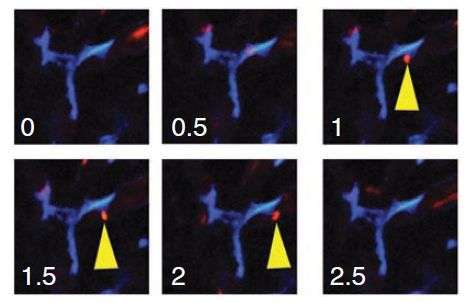June 17, 2013 report
Researchers find platelets play a collaborative role in eradicating blood borne bacteria

(Medical Xpress)—A team of Canadian researchers has found that platelets in mice liver collaborate with special types of white blood cells to help capture bacteria. In their paper published in the journal Nature Immunology, the team reports that they found platelet collaboration while conducting microscopy studies of Kupffer cells.
Platelets are cell fragments that exist in the blood—their main job is to stop blood loss during an injury by causing blood to clot. Prior evidence has suggested they may also play a role in some immune responses—they have receptors that are known to combat pathogens. In this new effort the research team has found that it appears they also help ward off bacterial infections by collaborating with special types of white blood cell known as Kupffer cells. Kupffer cells are one of many types of phagocytes—cells that clean the blood by eating bacteria and dead cells.
While watching Kupffer cells under normal conditions, the researchers noted that when they came in contact with platelets, there was a touch-and-go moment between the two—the platelet would bind with the Kupffer cell for just a moment, then let go. Such moments were possible, the researchers noted, because Kupffer cells collect a type of glycoprotein on their surface which is able to bind with another type of glycoprotein that resides on the surface of platelets. When bacteria were present, however, they found that instead of a touch-and-go moment the two types of cells interacted longer and in ways that resulted in the Kupffer cells eating bacteria—more than they would have, it turned out, in the absence of the platelets.
To find out how much assistance the platelets were offering in helping to capture bacteria, the researchers tested mice with platelet deficiency. They found that such mice succumbed to certain liver bacterial infections at a much higher rate than did mice with normal levels of platelets. That shows, the researchers contend, that platelets are actually part of the immune system—at least in mice.
Other research will have to be carried out to find out if platelets play the same role in humans. If they do, it might mean altering how some diseases are treated. Some drugs, such as aspirin, for example, lower the levels of platelet function in the blood and because of that, might be hampering the immune system.
More information: Nucleation of platelets with blood-borne pathogens on Kupffer cells precedes other innate immunity and contributes to bacterial clearance, Nature Immunology (2013) doi:10.1038/ni.2631
Abstract
Through the use of intravital imaging of the liver, we demonstrate a collaborative role for platelets with Kupffer cells (KCs) in eradicating blood-borne bacterial infection. Under basal conditions, platelets, via the platelet-adhesion receptor GPIb, formed transient 'touch-and-go' interactions with von Willebrand factor (vWF) constitutively expressed on KCs. Bacteria such as Bacillus cereus and methicillin-resistant Staphylococcus aureus (MRSA) were rapidly caught by KCs and triggered platelets to switch from 'touch-and-go' adhesion to sustained GPIIb-mediated adhesion on the KC surface to encase the bacterium. Infected GPIbα-deficient mice had more endothelial and KC damage than did their wild-type counterparts, which led to more fluid leakage, substantial polycythemia and rapid mortality. Our study identifies a previously unknown surveillance mechanism by which platelets survey macrophages that rapidly converts to a critical host response to blood-borne bacteria.
© 2013 Medical Xpress














